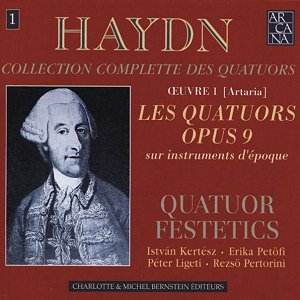|
|
Search MusicWeb Here |
|
 |
||
|
Founder:
Len Mullenger (1942-2025) Editor
in Chief:John Quinn
|
|
|
Search MusicWeb Here |
|
 |
||
|
Founder:
Len Mullenger (1942-2025) Editor
in Chief:John Quinn
|
 |
Joseph HAYDN (1732-1809) String Quartets, Opus 9 Quartet No. 1 in C major Quartet No. 2 in E flat major Quartet No. 3 in G major Quartet No. 4 in D minor Quartet No. 5 in B flat major Quartet No. 6 in A major Rec 6-9 August 1998, Bibliotghèque des Techniques, Budapest |
| CD available for post-free online mail-order or you may download individual tracks. For some labels you can download the entire CD with a single click and make HUGE savings. The price you see is the price you pay! The full booklet notes are available on-line. | |
|
NOTE • Click on the button and you can buy the disc or read the booklet details • You can also access each track which you may then sample or down load. • Further Information. |
|
|
Haydn's six Quartets, Opus 9, represent an important landmark in his development, as do the 'Sturm und Drang' symphonies (such as the Trauer and the Farewell, Nos. 44 and 45) from the early 1770s, with which they are contemporary. Not that the quartets are works of 'storm and stress': Haydn evidently regarded the quartet medium as too domesticated for that. However, there is no question that their sophistication of technique and directness of expression mark them as music of some importance, not merely music for entertainment. Indeed, the composer evidently thought so, since in later life he referred to them as 'the compositions in which I came of age'.
Listening to these six quartets brings all these considerations into focus. For the music is direct and engaging, always sounding well while bringing many surprises along the way. These performances by the Hungarian group, the Quatuor Festetics, are nicely recorded, with a suitable ambience to balance sonority and detail, and with tempi and phrasing that never fail to seem appropriate. Take, for example, the beautifully judged opening of the Adagio third movement of Quartet No. 4 (CD1, TRACK 3: 0.00), whose smoothly flowing contour is soon balanced by a firmer rhythm as a violin solo.
In all six pieces Haydn's preference is to place his slow movements third, after the minuets. In general this is probably because the opening movements adopt relatively slow tempi: the first movement of Quartet No. 1 (CD1, TRACK 5: 0.00) is a particularly telling example, with a phrase structure which has a strong emotional pull.
In this sense the real exception is the final work of the set, the Quartet No. 6, in which the unequivocal Presto tempo creates an intensity all of its own (CD2, TRACK 9: 0.00). Of course these compositions were not conceived to be played together at the same time, so the point behind the comparison has to be to make us aware of Haydn's freshness and inexhaustible imagination and sheer range. Not that No. 6 is the only movement to have a sense of lively activity and attack. In their own ways the various finales achieve this, a good example being the Presto of Quartet No. 4 (CD1, TRACK 4: 0.00). And this movement is useful also as a typical example of Haydn's quartet technique at this phase of his career. It would be several years before he embarked upon a process involving a 'partnership of equals', in the Opus 33 set which so inspired Mozart.
Here he prefers to give the principal melodic material to the top line, giving the remainder of the ensemble a supporting role. But what imaginative support it is. Either with contrapuntal lines of imaginative harmonies, his textures are never the routine textures of theme-and-accompaniment, and the music always holds abundant interest for both the players and the listener. In this regard the achievement of the Quatuor Festetics is not to be taken for granted, and they perform the music with consummate skill and dedication. They use what the excellent booklet note describes as 'original instruments', but the performances are big-boned, direct and sonorous. To some extent this is because the acoustic is ample and the recording close and somewhat larger-than-life. Whatever the context, the music emerges with vitality and freshness, and surely that is all that matters. Terry Barfoot
|
| ADDITIONAL INFORMATION •
You can sample only 30 seconds (or 15% if that is longer) of a given track. Select from the View tracks list. Each sample will normally start from the beginning but you can drag the slider to any position before pressing play. • PLEASE NOTE: If you are behind a firewall and the sound is prematurely terminated you may need to register Ludwig as a trusted source with your firewall software.
•You will need Quicktime to hear sound samples. Get a free Quicktime download here • If you cannot see the "Sample All Tracks" button you need to download Flash from here.
|
|
|
Return to Index |